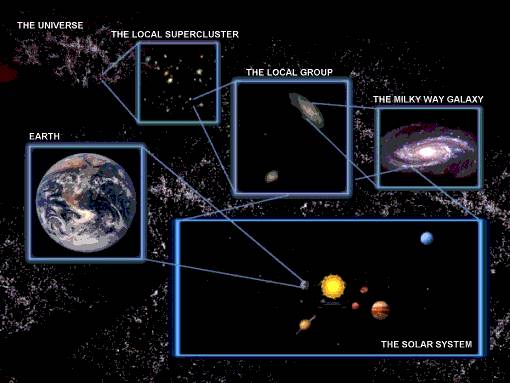The Scales of the CosmosThe vastness
of the cosmos and the things that make up the cosmos are a real challenge
to our minds as we begin the study of Astronomy. Below are some of the
dimensions most important to us at the beginning of our course. We, out
of necessity, employ Scientific Notation, when using these numbers. We
do not normally use English units (inches, feet, miles, etc.; but for conversion
purposes recall that 1 mile ~ 1.6 km and 1 km ~ 0.6 mile).
Starting from the
"small" to the truly enormous, the dimensions of the following are interesting
to contemplate. Items in red are important
terms in the first unit. The important
definitions you
must memorize. In the following
table, the first column lists the dimension, the second column its distance/size
in the appropriate unit, and the third column is that dimension in terms
of our
Thousand
Yard Walk.
| Dimension |
Measure |
Thousand
Yard Walk |
| The diameter of the
earth |
~12,700
km = 1.27 x 10 4 km |
0.08 inch |
| The average distance
to the moon |
~ 384,000
km = 3.84 x 10 5 km |
2.5 inches |
| The diameter of the
sun |
~ 1,400,000
km =1.4 x 10 6 km |
8.6 inches |
| The average distance
of the sun |
~ 1.49
x 10 8 km = 1 astronomical unit (au)(important
definition!) |
77.5 feet |
| The average distance
to Pluto |
~
5.8 x 10 9 km = 39 au |
3022.5
feet ~ 3/5 mile |
| A light
year (the distance light travels in one year at a speed
of 300,000 km/sec) (important definition!) |
~ 9.46
x 10 12 km (about 5.9 trillion miles) |
931 miles |
| The distance to the
nearest star (Proxima Centauri) |
~ 4.2 ly |
3,900 miles |
| Center of our galaxy |
~ 25,000
ly |
23,000,000
miles |
| Our galaxy
(the Milky Way) |
~ 80,000
ly |
75,000,000
miles (comparable to the actual orbit of Venus) |
| Nearest big galaxy
(M31
in Andromeda) |
~ 2.6 million
ly |
2.4 billion
miles (from here to Neptune) |
| Nearest big galaxy
cluster (Virgo) |
~ 50 million
ly |
~ 50 billion
miles (16 times farther than Pluto) |
| Nearest quasars |
~
1 billion ly |
~ 2 ly |
| Edge of the observable
universe |
~ 14 billion
ly |
~ 28 ly
(about as far as Vega) |
The Units we will use in Astronomy:
| Name (with abreviation) |
Equivalent |
Typical
Phenomenon |
| 1 angstrom (Å) |
1 x 10-10
m |
Size of
an atom |
| 1 nanometer (nm) |
10 Å
= 1 x 10-9 m |
One wave
of X-radiation |
| 1 meter (m) |
1000 mm
or 0.001 km |
Moderate sized meteoroid
|
| 1 kilometer (km) |
1000 or
1 x 10³ m |
Small asteroid |
| 1 astronomical
unit (au) |
1.49 x
10 8 km |
Earth-sun
distance; diameter of a red giant star |
| 1 light-year
(ly) |
9.46 x
10 12 km |
Extent
of the solar system (including the
Oort Cloud) |
| 1 parsec (pc) |
3.26 ly |
Distance
between "neighboring" stars |
| 1 kiloparsec (kpc) |
1000 pc
= 32,600 ly |
Giant molecular
cloud (star forming region of a galaxy) |
| 1 megaparsec (Mpc) |
1 million
parsecs |
Distance
between "neighboring" galaxies |
Our study of astronomy takes us from
the very smallest particles in the universe (electrons that are involved
in the creation of the light we see) the the very largest known structures
in the universe (filaments that are
vast chains of galaxy clusters).
Of interest might be the description
of our Cosmic Address (apologies to Thornton Wilder who wrote "Our
Town").
| Our
Cosmic Address |
 |
| This figure illustrates our cosmic
address. The Earth is one of the nine planets in our solar systems, our
solar system is one among more than 100 billion star systems in the Milky
Way Galaxy; the Milky Way is one of the largest of about 30 galaxies in
the Local Group; the Local Group lies near the outskirts of the Local Supercluster;
and the local Supercluster fades into the background of structure throughout
the universe. Wilder adds, "...the Universe, the Mind of God."
Concept and image credit: Aeree & Ben's Astronomy
Lab of Columbia University
http://www.astro.columbia.edu/~archung/labs/fall2001/lec01_fall01.html.
Used with permission of the author.
|
